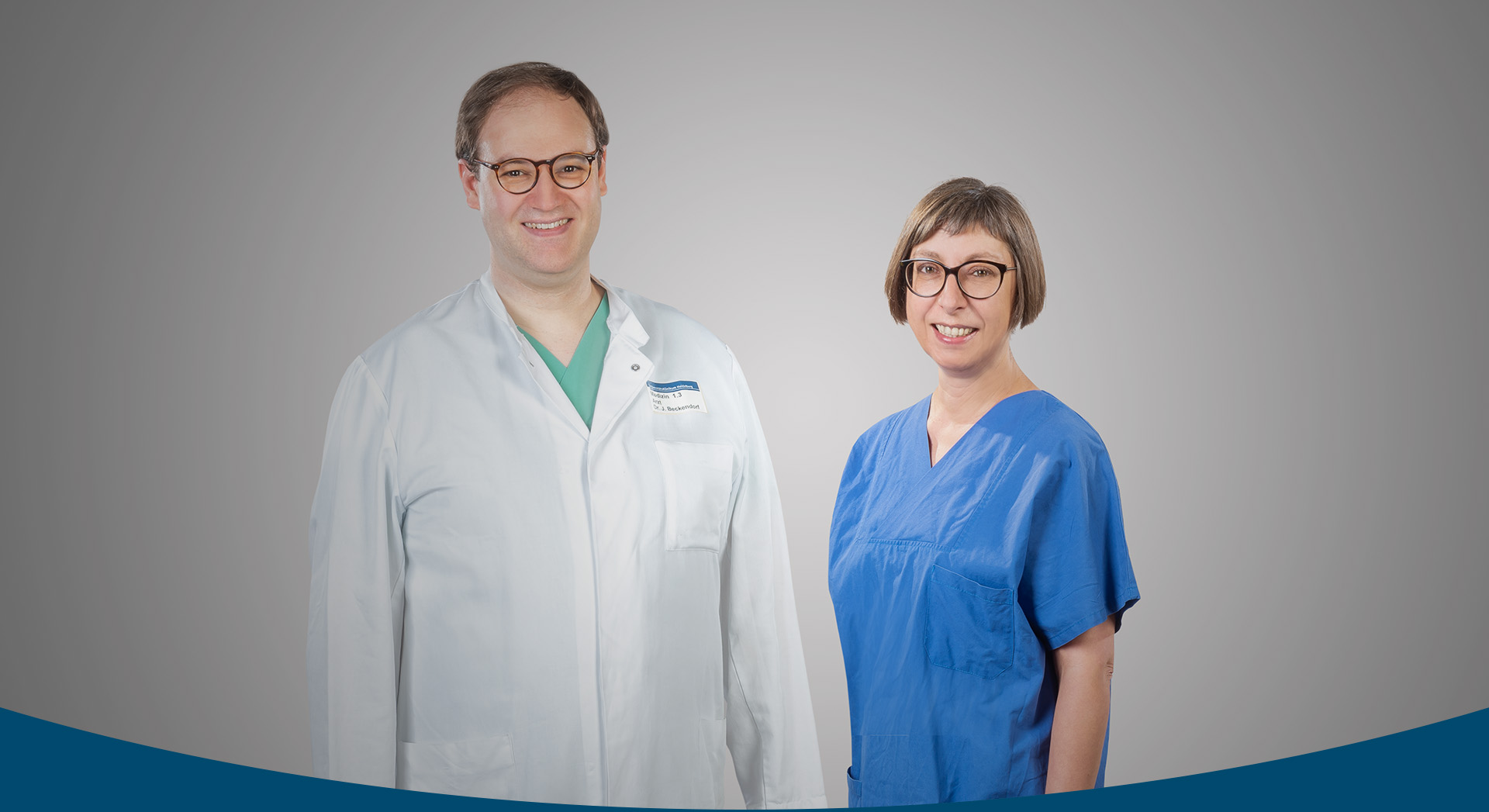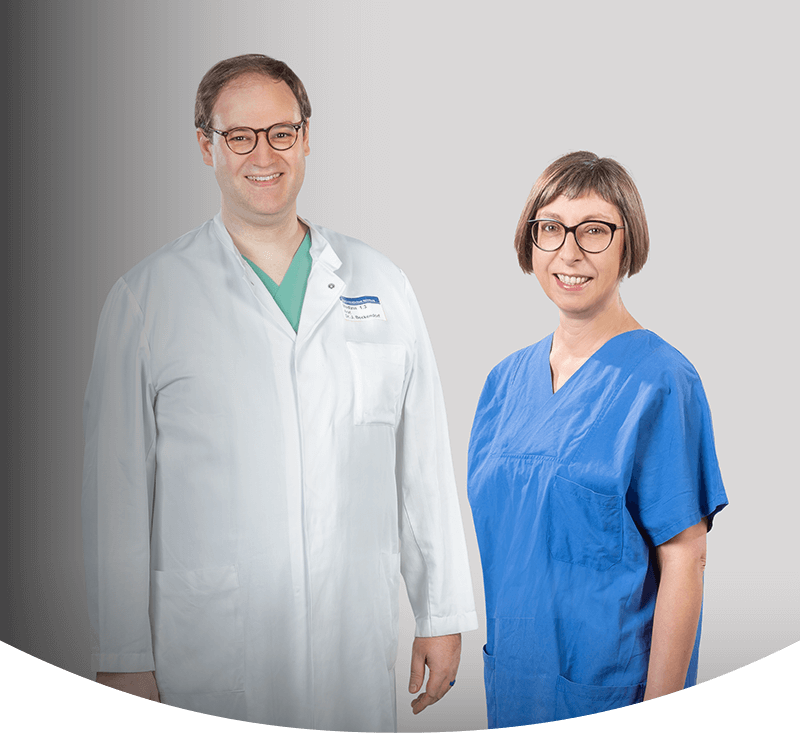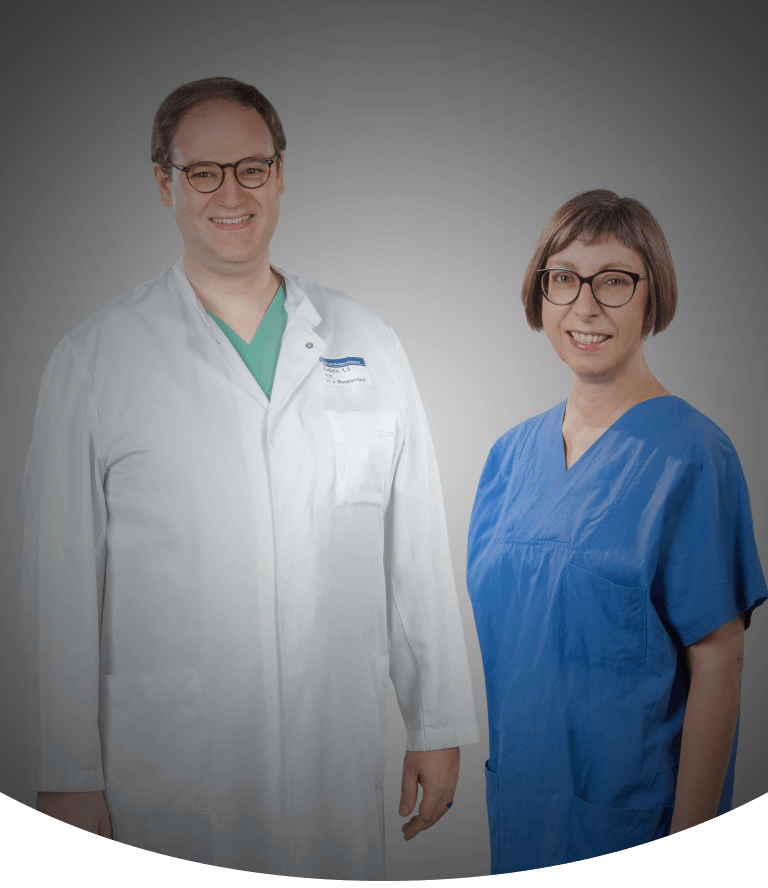Team 01
Back
to Team Overview



1
Team Cardiologist & Heart Nurse explains
WHAT IS CLOSE TO OUR HEARTS?
Dr. Jan Beckendorf
Cardiologist
Dr. Jan Beckendorf, a specialist for internal medicine and a cardiologist, is an expert for advanced heart failure and has worked at Heidelberg University Hospital since 2012.
Elke Felleisen
Heart Nurse
Elke Felleisen is a nurse in the intensive cardio care unit and in intensive monitoring care (IMC) of the Department of Cardiology, Angiology and Pneumology and has worked as a nurse for almost 40 years.
Nurses and physicians work together closely. Always. But when a diseased, weak heart is barely able to perform, their team work is more important than ever. Elke Felleisen and Jan Beckendorf jointly look after seriously ill heart patients. They interact as equals, and fight side by side for patients whose only hope for a normal life is an organ transplant. They pass on their extensive knowledge to young nurses in the Heidelberg Heart Nurse Course.
An additional qualification is truly important
There has been a “Heart Nurse” Course in Heidelberg since 2013. It bundles competencies and the viewpoints of nursing experts and physicians from the Department of Internal Medicine and was developed in cooperation with the Akademie für Gesundheitsberufe (Academy for Healthcare Professions), to better meet the special needs of heart patients.
During the six-day course, nurses acquire specialized knowledge related to heart diseases, such as learning how to better assess specific values, recognize symptoms, and become more confident when dealing with chronically ill heart patients.
The team
having a discussion

Dr. Jan Beckendorf
Strong teams are essential for the survival for our heart patients. Both – the physician and the nurse(s) – must work together closely and competently in the interests of the critically ill patient.

Elke Felleisen
It must be noticed immediately if a patient has changed. Even if patients go for walks with the help of a rollator walker, this does not mean that they are fit … These are seriously ill persons. If I notice something, I know when I have to fetch Jan.

Dr. Jan Beckendorf
When Elke comes to me with beads of perspiration on her forehead, I immediately leap into action! However, there is not always enough time to fetch a physician. Cardiac arrhythmias often occur without any warning and then every minute counts. You have to run and get the defibrillator! Nurses need a lot of specialized knowledge here in order to be able to act independently.

Elke Felleisen
It is a good thing that we have our Heart Nurse Course. I believe that it gives our colleagues here a lot of confidence.

Dr. Jan Beckendorf
Nursing is challenging here, not only on the medical, but also on the human level. If patients have to spend months in the heart failure monitoring ward and are waiting for a donor organ, you have to provide psychological support somehow, because sooner or later everyone is sick and tired of being in the hospital. They are constantly being monitored and cannot leave the hospital. And everyone – almost without exception – is afraid. This is a major challenge, especially for the nurses.

Elke Felleisen
A patient once said “this is like being in a prison, but without release”. He spent over a year with us and finally received a new heart. Have you read his book? I like to read excerpts from the book in the course. It helps us a lot to perceive our own routine activities from the patient’s point of view.
Excerpt from the book “Herr Sutter und seine Schwestern” by Jörg Metzinger, published by Geistkirch Verlag.
Mr. Sutter listens carefully. Once again there is a cry: “Eeelke!” His monitor is still on his rollator walker and Mr. Sutter is in a long corridor with his walker. He does not need the walker to walk; this distinction is important to him. He only needs the walker to carry his monitor. In other words, the walker is not a walking aid for Mr. Sutter, who has always been estimated to be ten years younger by his confirmation candidates, no, not a walking aid, but permission to walk. This monitor is linked to him day and night, without any interruptions. It monitors his pulse, and sounds the alarm if ventricular fibrillation, which is dangerous, begins. Within a few seconds, both nurses and physicians then stand next to him. The nurses filter this characteristic tone, a wild ringing sound, out of the other noise on the ward.
Initially, everything sounded the same to Mr. Sutter. In the meantime he also hears the differences. And knows, that now they are going to dash off, all hell is breaking loose, and perhaps this means life or death. And the staff on duty in the ward fight death for someone’s life. Sounds pathetic? Mr. Sutter is able to be pathetic by virtue of his occupation. Now he remains calm. Just as his eldest son is always telling him to do.
In the “monitoring area” – a room for nurses in the middle of the corridor, the screens flicker with all of the signals from the patients. Green spiky pulse signals, occasional flashing mysterious notices: CPT or AIVR. He now knows what these abbreviations mean. CPT, for example, means that the heart is briefly beating abnormally fast. These green lines also come together in the physician’s office. If worst comes to worst, they reach him in only a few seconds: Nurse Bianca or Andrea, mostly both and Brigitte as well, and the physicians, Lukas or Mr. Schotthelm.
A few seconds and he is saved. Because they know how to bring you back to life.
Final question
When was the first heart transplant in Heidelberg?
A1967
B1989
Incorrect!
The first successful heart transplant in the world took place in 1967 – performed by Christiaan Barnard in Cape Town at that time.
Correct!
The first patient at Heidelberg University Hospital received a new heart in 1989.
Would you like to meet other strong teams from Heidelberg?
2
Team Nutritionist & Social Services explains
WHO HELPS CANCER PATIENTS IN THEIR EVERYDAY LIVES
JOIN THE CONVERSATION
3
Team Medical Physicist & MTRA explains
WHO ACTIVATES HEAVY IONS?
JOIN THE CONVERSATION
4
Team Media Didactics Specialist & IT Specialist explains
WHERE IS KNOWLEDGE BEING DIGITIZED?
JOIN THE CONVERSATION


